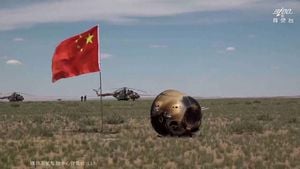The Ukraine crisis deepens as conflict escalates between military forces, fueling extensive international concerns. Following the destruction of strategic bridges within Russia's borders, the Ukrainian offensive has provoked severe retaliation from Moscow.
Recently, Ukrainian forces successfully obliterated another key bridge located about seven miles inside Russia, targeting infrastructure deemed valuable for enemy logistics. This surgical strike was documented and shared by Mykola Oleshchuk, commander of the Ukrainian Air Force, who emphasized its significance.
Responding to the attacks, Russian President Vladimir Putin ordered airstrikes on Ukrainian territory, including Kyiv, indicating he is unwilling to back down. Reports suggest Ukrainian air defenses managed to intercept all incoming missiles, thwarting significant casualties.
Ukrainian President Volodymyr Zelensky claimed his country confronted over 40 missile attacks, along with numerous drones and guided bombs last week. Stemming from these attacks, Ukraine has denounced Russia’s targeting as “deliberate and targeted Russian terror,” citing the casualties and devastation inflicted on civilian areas.
Despite the persistent struggle, Zelensky has asserted the intention behind Ukraine’s advances is to establish buffer zones against Russian threats. The offensive is reportedly the most significant Ukraine has launched since World War II, catching Russian forces off guard.
This counter-offensive has resulted not only in the seizure of villages but also the capture of hundreds of Russian soldiers. Commander Oleksandr Syrskyi proclaimed Ukrainian forces extended their territorial grip, advancing across approximately 1,000 square kilometers.
With the violence reigniting concerns over nuclear safety, the International Atomic Energy Agency (IAEA) has intensified warnings. Recently, drone strikes near the Zaporizhzhia Nuclear Power Plant raised alarms, prompting Rafael Grossi, the agency’s director, to call for restraint.
Grossi highlighted the deteriorated safety conditions at the plant, reporting direct military activity dangerously close to nuclear installations. The IAEA emphasized the need for strict enforcement of protocols to safeguard such facilities amid the chaos of war.
Evidence from IAEA observations shows rising military actions near the Zaporizhzhia site, marked by frequent explosions and artillery. Although there were no direct impacts on the plant’s operational capabilities, the potential for future calamities looms as violence persists.
Calls for cooling tensions have often been ignored by both Kyiv and Moscow, with each side pushing the blame for escalations. Authority figures like Grossi continuously press for the safety of nuclear plants, stressing not just the human risks, but also the global ramifications of nuclear incidents.
Experts are also positing the possibility of Ukraine aiming to seize control of another nuclear facility to leverage it during negotiations. Analysts speculate such actions could provide Ukraine with strategic advantages as it continues to reclaim lost territory.
With the war’s nature growing increasingly intense, the concept of tit-for-tat retaliation becomes pervasive. Both Ukraine and Russia are showing no signs of backing down from their positions, continuing to engage deeply and destructively.
This intensified conflict leads many to contemplate the precariousness of the current situation and its broader impacts. Analysts and leaders worldwide are left grappling with the unknown consequences as military efforts spiral, drawing attention to global stability and safety.



